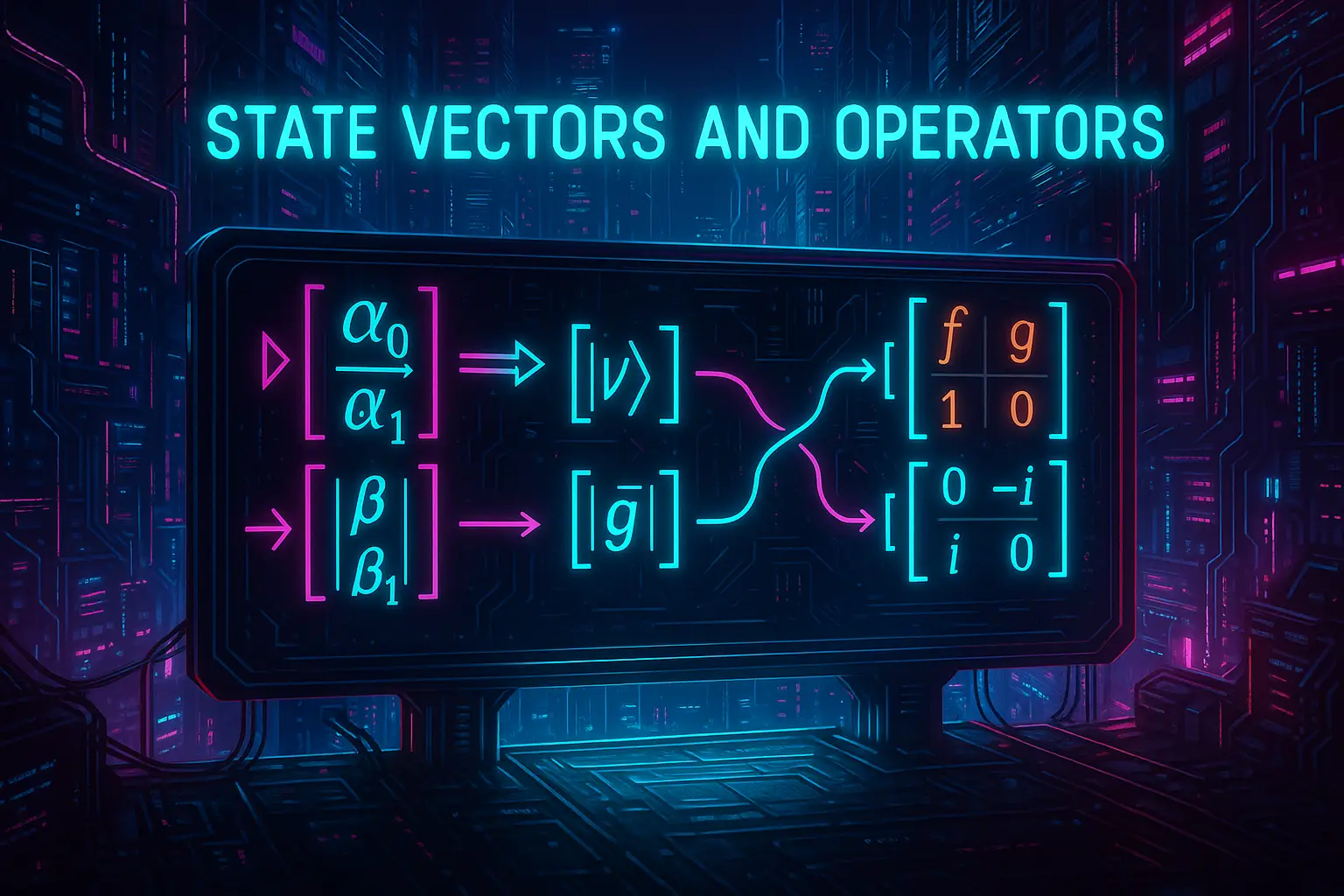Table of Contents
- Introduction
- Quantum States and Hilbert Space
- Bra-Ket Notation
- Properties of State Vectors
- Orthogonality and Completeness
- Observables as Operators
- Hermitian Operators and Measurement
- Eigenvalues and Eigenvectors
- Expectation Values and Variance
- Operator Algebra
- Commutators and Uncertainty
- Projection Operators
- Unitary and Anti-Hermitian Operators
- Examples of Common Operators
- Conclusion
1. Introduction
Quantum mechanics is formulated in terms of state vectors and operators. These mathematical objects define how systems evolve, how observables are represented, and how measurements are made. They reside in a Hilbert space, which provides the formal setting for quantum theory.
2. Quantum States and Hilbert Space
A quantum state is described by a vector \( |\psi\rangle \) in a complex Hilbert space \( \mathcal{H} \).
- The space is complete, linear, and endowed with an inner product
- Physical information is contained in the state vector, up to a global phase
- The norm is always 1:
\[
\langle \psi | \psi \rangle = 1
\]
3. Bra-Ket Notation
Introduced by Dirac, bra-ket notation simplifies inner products and operators.
- Ket: \( |\psi\rangle \): column vector
- Bra: \( \langle\psi| \): complex conjugate transpose
- Inner product: \( \langle\phi|\psi\rangle \)
- Outer product: \( |\phi\rangle\langle\psi| \): operator
4. Properties of State Vectors
- Linear superposition:
\[
|\psi\rangle = \alpha |\phi_1\rangle + \beta |\phi_2\rangle
\] - Normalization:
\[
\langle \psi | \psi \rangle = 1
\] - Two states \( |\psi\rangle \) and \( e^{i\theta} |\psi\rangle \) are physically equivalent
5. Orthogonality and Completeness
- Orthogonal: \( \langle \psi | \phi \rangle = 0 \)
- Orthonormal basis: \( \langle e_i | e_j \rangle = \delta_{ij} \)
- Completeness:
\[
\sum_i |e_i\rangle \langle e_i| = \hat{I}
\]
Enables expansion of any state in terms of basis vectors.
6. Observables as Operators
Every observable corresponds to a Hermitian operator \( \hat{A} \).
- Acts on state vectors to yield eigenvalues
- Hermitian condition:
\[
\hat{A}^\dagger = \hat{A}
\]
Operators encapsulate measurable physical quantities (e.g., position, momentum, energy).
7. Hermitian Operators and Measurement
- Measurement outcomes are real eigenvalues
- Upon measurement of \( \hat{A} \), the system collapses into an eigenstate \( |a\rangle \):
\[
\hat{A}|a\rangle = a|a\rangle
\]
Hermitian operators have:
- Real spectrum
- Orthogonal eigenstates
- Spectral decomposition
8. Eigenvalues and Eigenvectors
If \( \hat{A}|\psi\rangle = a|\psi\rangle \), then:
- \( |\psi\rangle \) is an eigenvector
- \( a \) is the eigenvalue
Eigenvectors form the measurement basis.
9. Expectation Values and Variance
The expectation value of an operator \( \hat{A} \) in state \( |\psi\rangle \) is:
\[
\langle \hat{A} \rangle = \langle \psi | \hat{A} | \psi \rangle
\]
Variance (measure of spread):
\[
(\Delta A)^2 = \langle \hat{A}^2 \rangle – \langle \hat{A} \rangle^2
\]
10. Operator Algebra
Operators can be added and multiplied:
- Linear: \( \hat{C} = \alpha \hat{A} + \beta \hat{B} \)
- Product: \( \hat{A}\hat{B} \neq \hat{B}\hat{A} \) generally
- Associative but not commutative
11. Commutators and Uncertainty
Commutator:
\[
[\hat{A}, \hat{B}] = \hat{A}\hat{B} – \hat{B}\hat{A}
\]
Example:
\[
[\hat{x}, \hat{p}] = i\hbar
\]
Leads to Heisenberg uncertainty principle:
\[
\Delta x \Delta p \ge \frac{\hbar}{2}
\]
12. Projection Operators
Project a state onto a basis vector:
\[
\hat{P}_a = |a\rangle\langle a|
\]
Used in measurement theory and quantum logic.
13. Unitary and Anti-Hermitian Operators
- Unitary: \( \hat{U}^\dagger \hat{U} = \hat{I} \)
- Preserve inner products
- Represent time evolution
- Anti-Hermitian: \( \hat{A}^\dagger = -\hat{A} \)
14. Examples of Common Operators
- Position: \( \hat{x} \), acts as multiplication
- Momentum: \( \hat{p} = -i\hbar \frac{d}{dx} \)
- Hamiltonian: total energy, governs dynamics
- Pauli matrices: act on spin-1/2 particles
15. Conclusion
State vectors and operators are the mathematical language of quantum mechanics. They describe the evolution, measurement, and properties of quantum systems. Mastery of these concepts is essential for understanding everything from fundamental quantum theory to quantum computing and field theory.


